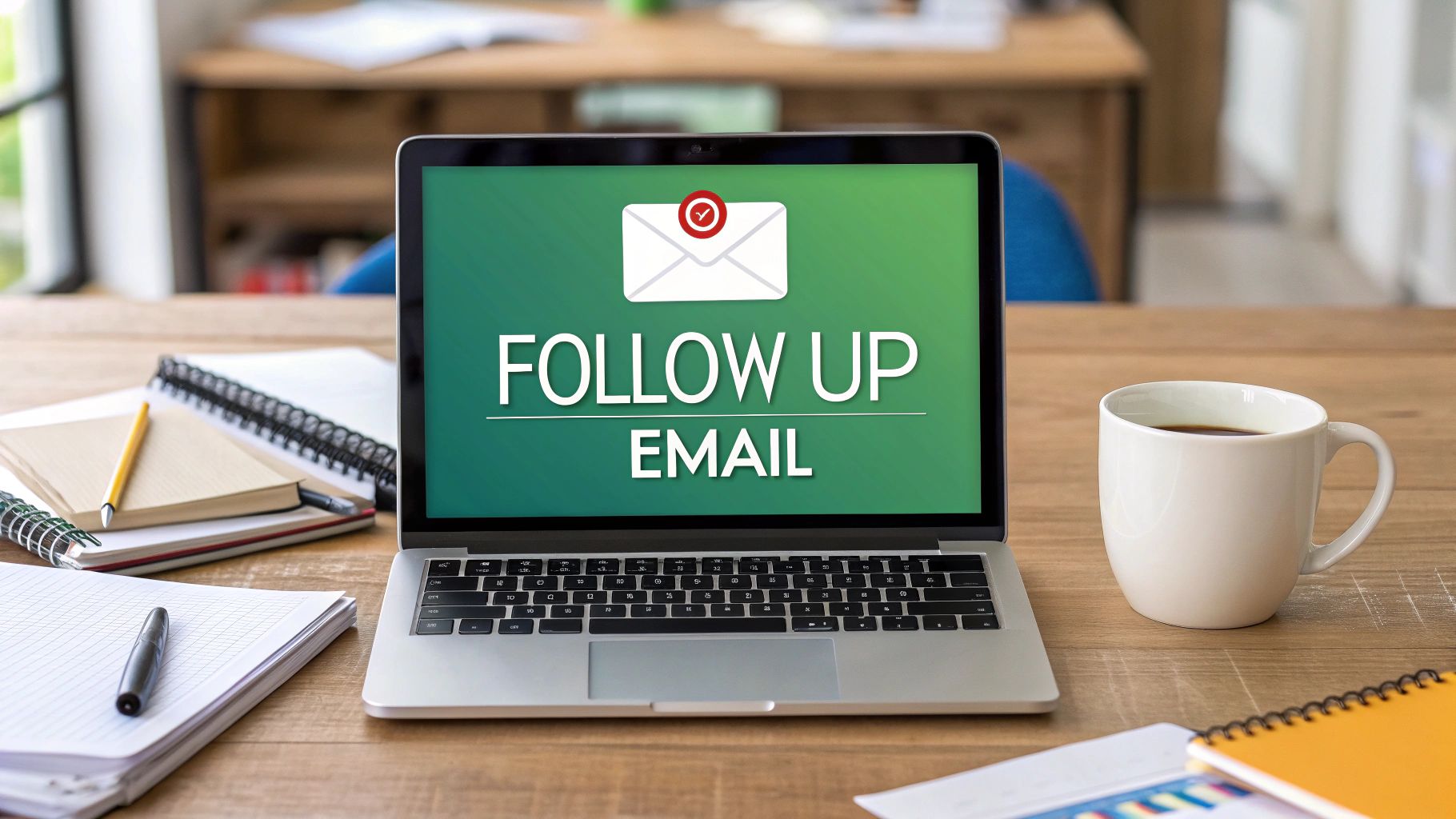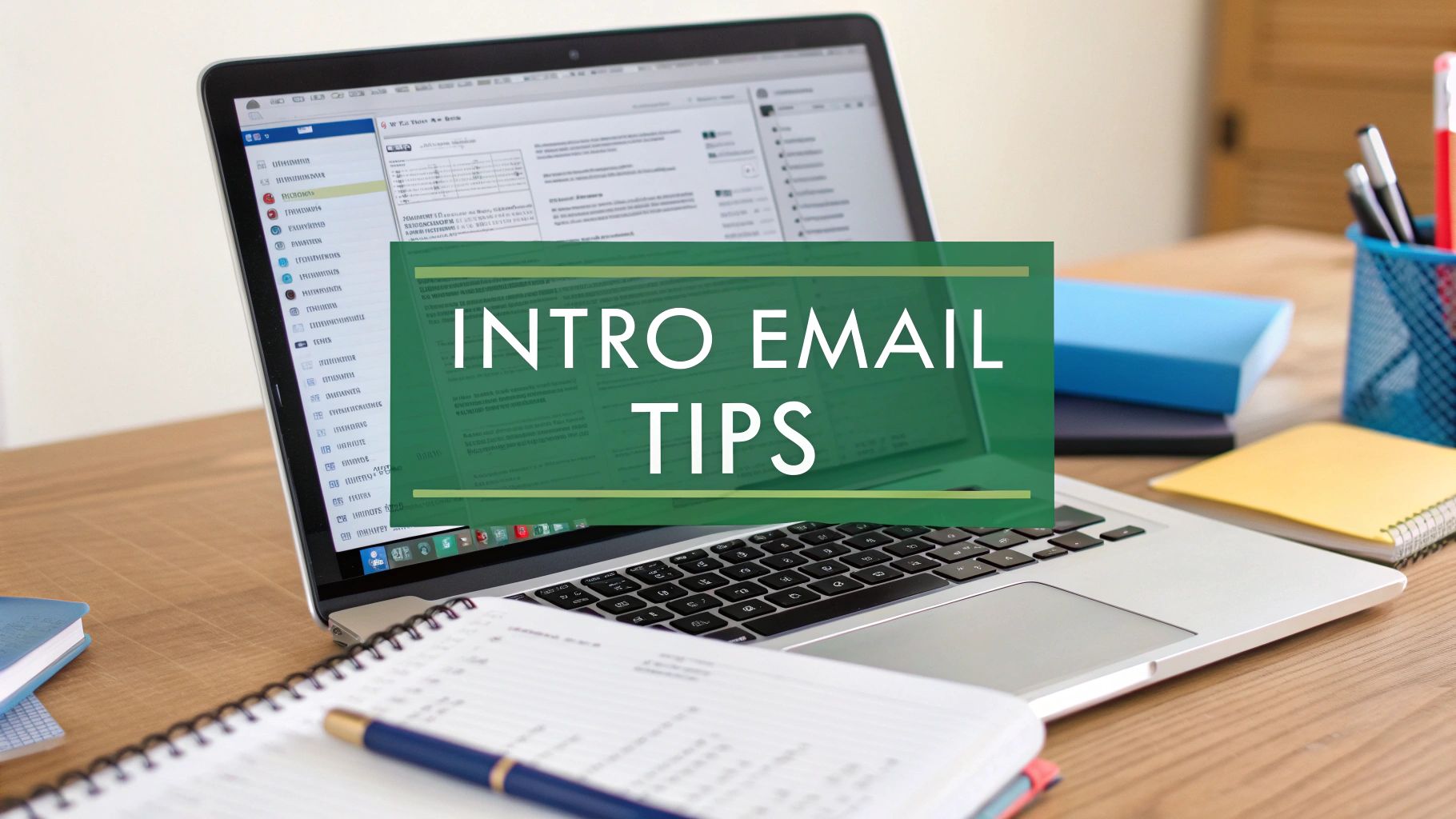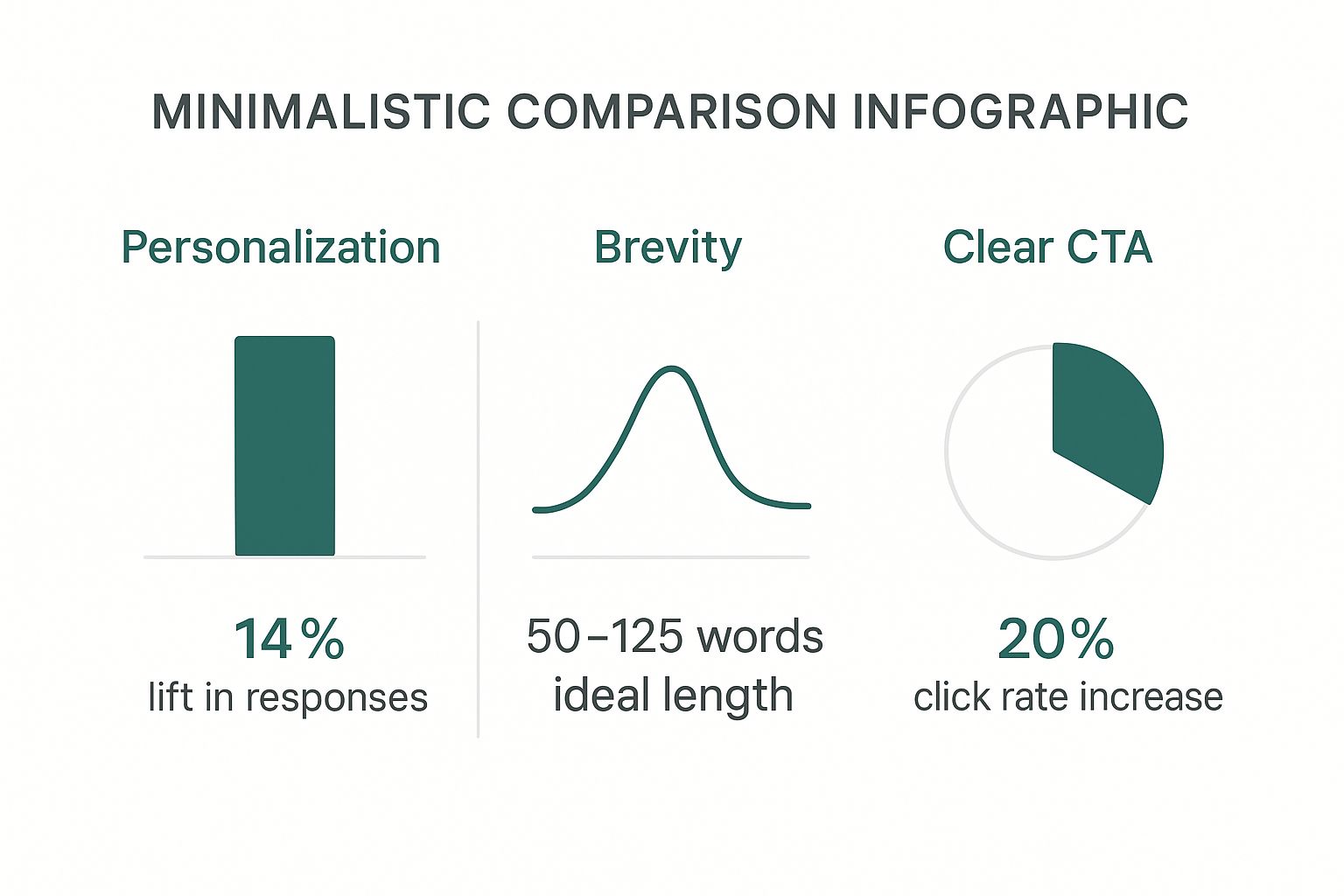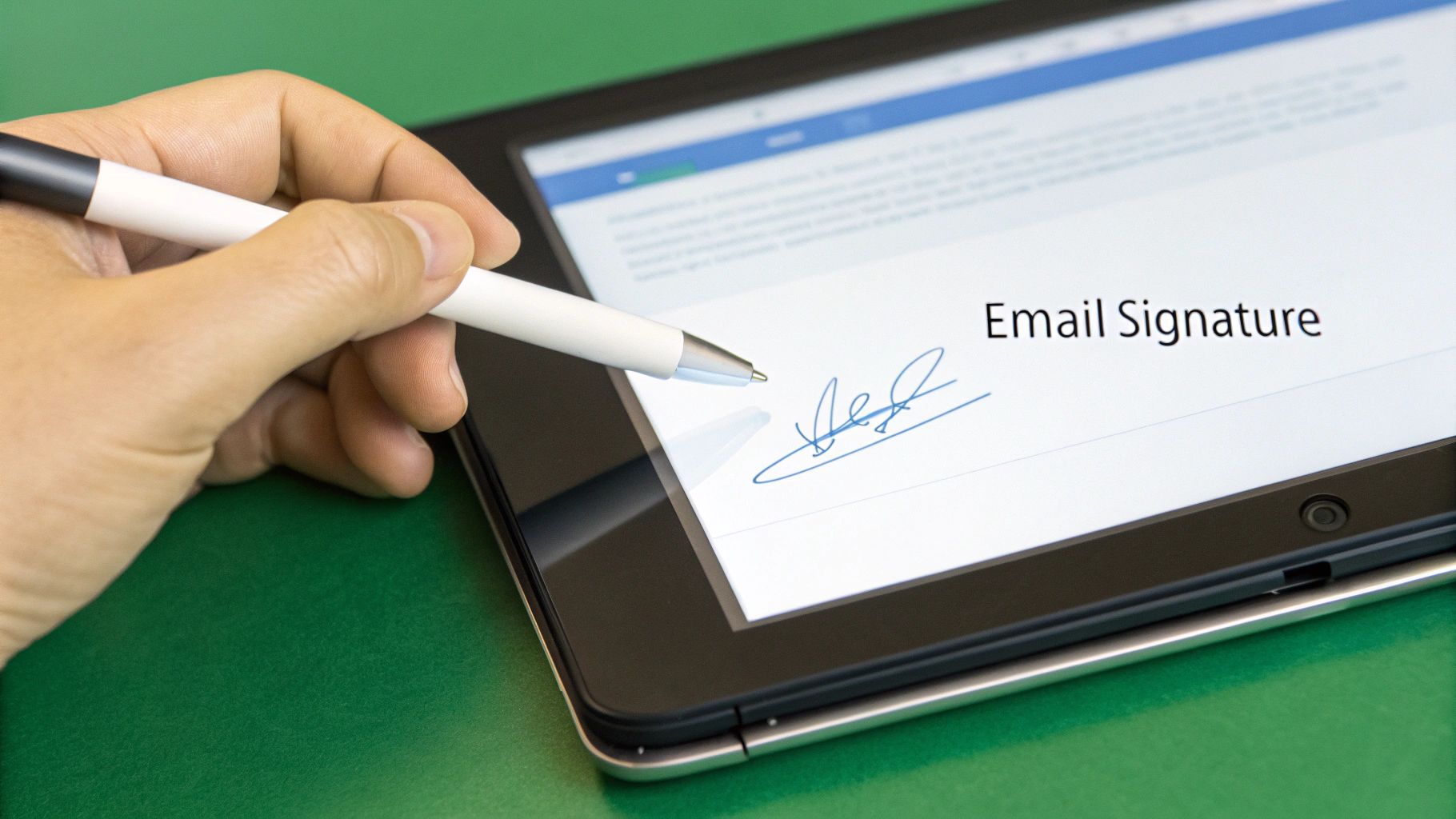So, you sent an email and got… crickets. What now?
Before you even think about hitting 'send' on a follow-up, let’s take a step back and do a quick post-mortem on that first message. It’s tempting to jump to conclusions, but the silence is rarely personal. More often than not, it boils down to a few common, fixable issues. We're not here to dwell on mistakes; we're here to refine your approach so the next email is impossible to ignore.
Why Your First Email Was Ignored

Let's be real—it’s easy to assume the worst when an important email goes unanswered. Thoughts like "they're not interested" or "I came on too strong" can start creeping in. But the truth is usually much simpler and has everything to do with their inbox, not your idea.
The average professional gets hit with over 120 emails per day. That’s a firehose of information, and it's incredibly easy for even a well-intentioned message to get lost in the flood. Instead of guessing, let's diagnose why the first email might have been missed. This self-audit is the key to not making the same mistake twice.
Common Reasons for Radio Silence
Forget the generic "they're just busy" excuse. Let's dig into the real, actionable reasons your message was probably overlooked.
- Your Subject Line Was Camouflaged: Did your subject line blend into the sea of other emails? Anything generic like "Checking In" or "Quick Question" is a one-way ticket to the archive folder. It screams low-priority because it doesn’t signal any real value.
- The Timing Was Off: A Monday morning email is competing with a weekend's worth of backlog. A late Friday afternoon message is up against someone whose brain has already checked out for the weekend. Timing matters.
- Your "Why" Was Buried: Could they tell immediately what you were offering and why it should matter to them? If someone has to put in effort to figure out the point of your email, they simply won't. Clarity is king.
- It Never Even Arrived: Sometimes, the problem isn't your copy—it's a technical hiccup. Your email could have been flagged by a spam filter. For any crucial outreach, it’s always smart to validate an email address first to give your message the best shot at landing in the primary inbox.
The Power of a Personal Touch
The difference between average and amazing outreach is staggering. Most cold email campaigns see response rates hovering between a bleak 1% and 8.5%. It’s just the nature of the game.
But here’s the game-changer: campaigns that are highly targeted and feel personal can see those reply rates skyrocket to an incredible 40% or even 50%.
The single most effective change you can make is to write an email that feels like it was crafted for one person, not a thousand. That's what gets a response.
To put these ideas into action, let's quickly summarize what an effective follow-up strategy looks like.
Quick Follow-Up Strategy Overview
This table breaks down the core principles for turning silence into a conversation.
| Principle | Actionable Tip | Why It Works |
|---|---|---|
| Patience is Key | Wait 3-5 days before sending your first follow-up. | Gives the recipient enough time to see and act on the original email without making you seem desperate. |
| Add Context, Not Clutter | Reply in the same email thread to keep the original message for context. | Makes it easy for them to recall the initial outreach without having to search their inbox. |
| Deliver New Value | Offer a new piece of information, a helpful resource, or a different angle. | Turns the follow-up from a simple "nudge" into a valuable touchpoint that helps them. |
| Keep It Simple | Make your follow-up email even shorter and more direct than the first one. | Respects their time and makes it incredibly easy for them to read and respond quickly. |
Following these guidelines helps ensure your next email doesn't just get delivered—it gets noticed. Now, let’s get into crafting the perfect follow-up.
Anatomy of an Effective Follow-Up Email

Let's get one thing straight: writing a follow-up email after getting radio silence isn't about being louder. It's about being smarter. The whole point is to gently re-engage, not to demand a response. A truly great follow-up is quick, adds a little extra value, and makes it dead simple for them to reply.
I've found that the best follow-ups—the ones that actually get a response—are built on four key components. Think of them as a simple formula that turns a forgotten email into a real conversation starter. Get these right, and you can nudge someone toward a reply without ever sounding pushy.
The Contextual Opener
Your very first sentence has one job: connect this email to the last one. Immediately. Forget vague lines like "just checking in" or "following up." You have to remind them of the specific context of your previous message.
This isn't just about being polite; it’s a strategic move. In fact, sales follow-up stats show that referencing a prior conversation can boost response rates by as much as 62%. It saves them the mental work of having to remember who you are and what you wanted.
- Bad Example: "Just wanted to follow up on my last email." (This is lazy and puts all the work on them.)
- Good Example: "Hi Alex, I'm following up on the email I sent last Tuesday about the Q3 marketing report." (Instantly specific and helpful.)
The Value-Add Component
This is where most people completely drop the ball. Just resending the same request is flat-out annoying. The secret to a follow-up that works is to offer something new. You have to give them a fresh reason to pay attention.
This doesn't have to be some grand gesture. The "value-add" can be something small but genuinely helpful that shows you're thoughtful and know your stuff. This one element is what turns a simple "nudge" into a useful touchpoint.
Your follow-up should never feel like a repeat. If you're not adding new value, you're just adding to the noise in their inbox.
So, what can you offer?
- A link to a new blog post or case study that's relevant to them.
- A surprising statistic you just came across about their industry.
- A quick answer to a question you think they might have.
The Clear and Simple CTA
Okay, so you've set the context and offered some new value. Now what? You have to tell them exactly what you want them to do next. A fuzzy or demanding call-to-action (CTA) is the quickest way to get your follow-up deleted. Your ask needs to be as low-friction as possible.
Instead of an open-ended question like "Let me know your thoughts," guide them with a simple, specific action. The easier you make it for them to reply, the more likely they will. The same principles apply here as in your first email—for a refresher, check out our guide on how to write cold emails that get responses.
- Bad Example: "I'd love to discuss this further when you have a moment." (This forces them to think and coordinate.)
- Good Example: "Does a quick 15-minute chat next Tuesday or Thursday work for you?" (Simple, closed options. Easy yes/no.)
The Professional Close
Finally, wrap it up on a positive, professional note. Your closing should be brief, polite, and show that you respect their time. This is your last chance to leave a good impression, whether they reply or not.
Steer clear of sign-offs that sound passive-aggressive ("Hope to finally hear from you") or desperate. A simple, confident closing line shows you're in control and that you value the potential relationship.
- Bad Example: "I’ll wait for your reply." (Comes off as impatient.)
- Good Example: "Looking forward to connecting when the time is right." (Polite, patient, and professional.)
Follow-Up Email Templates That Work
Knowing the theory is one thing, but seeing how it works in the real world is where the magic happens. Let's move from principles to practice with some templates you can adapt for the situations you face every day.
Think of these as your starting point, not a final script. The best emails always feel personal. Use these as a foundation, then tweak them to match your voice and the specific context. I'll break down the strategy behind each one so you understand why it’s so effective.
After Sending a Sales Proposal
You had a great discovery call, built some real rapport, and sent over a killer proposal. And now… crickets. Your goal here isn't to ask, "Did you get my proposal?" Instead, you want to re-engage by adding new, relevant value that keeps the conversation moving.
Subject: A few thoughts on [Their Company Goal]
Hi [First Name],
I was thinking more about our conversation last week and your goal to [mention their specific goal, e.g., streamline your onboarding process].
I came across this case study detailing how a company in the [Their Industry] space tackled that exact challenge and saw a 25% increase in efficiency. Thought you might find it insightful.
Any initial questions about the proposal I sent over? I'm happy to walk through it for 15 minutes if that’s helpful.
Best,
[Your Name]
- Why it works: This approach completely shifts the focus from "my proposal" to "your goal." You’re being a helpful resource, not a needy salesperson. The call-to-action is low-pressure and frames the next step as a clear benefit to them.
Nudging a Cold Lead
Following up on a cold email is a delicate dance. You don’t have a prior relationship, so your message has to be incredibly concise and jam-packed with value. You're trying to land a different, more compelling hook that might resonate better than your first attempt. When you're stuck, it helps to check out some proven examples of cold emails that convert to get fresh ideas for your entire sequence.
Subject: Re: [Original Subject Line]
Hi [First Name],
Just wanted to quickly follow up on my last email about [briefly restate your one-sentence value prop].
We recently helped [Similar Company] achieve [specific, quantifiable result], and it made me think of your team at [Their Company].
Is tackling [the problem you solve] a priority for you right now?
Best,
[Your Name]
Key Takeaway: A cold follow-up must be exceptionally short. It acts as a quick reminder, adds a dose of social proof with the similar company, and asks a simple, closed question that’s easy to answer with a "yes" or "no."
After Submitting a Job Application
That waiting period after applying for a job can be agonizing. A well-crafted follow-up email shows you're proactive and genuinely interested—but it has to be professional and respectful of the hiring manager’s time. This is your chance to reiterate your enthusiasm and highlight a key qualification.
Subject: Following up on my application for the [Job Title] role
Hi [Hiring Manager Name],
I hope you're having a productive week.
I submitted my application for the [Job Title] position last [Day, e.g., Tuesday] and wanted to briefly reiterate my strong interest in joining the team at [Company Name].
My experience in [mention one key skill from the job description, e.g., managing cross-functional marketing campaigns] aligns directly with the requirements you outlined, and I'm confident I can help your team achieve [mention a company goal, e.g., its Q4 growth targets].
Please let me know if there's any additional information I can provide.
Thank you for your time and consideration.
Sincerely,
[Your Name]
Reconnecting After a Networking Event
You met someone interesting at a conference, had a great chat, and followed up right away. If you don't hear back, a gentle nudge can restart things. The absolute key here is to reference your specific conversation to jog their memory and stand out from everyone else they met.
Subject: Great connecting at [Event Name]!
Hi [First Name],
It was a pleasure meeting you at [Event Name] last week. I really enjoyed our conversation about [mention a specific topic you discussed, e.g., the future of AI in marketing].
As promised, here's that article I mentioned on [Topic]. Thought you might find it interesting.
I'd love to continue our chat sometime. Are you free for a quick call next week?
Best,
[Your Name]
Strategic Timing and Frequency for Follow-Ups
So, you’ve sent your email and… crickets. The big question now is, when do you follow up? Jump in too soon, and you risk looking desperate. Wait too long, and your original message gets buried, completely forgotten. The sweet spot is a careful balance of persistence and respect.
As a general rule of thumb, give it 2-3 business days before you send that first nudge. This gives them a fair chance to read and respond without feeling rushed. After that, it’s a good idea to space out your next few attempts, adding a little more time between each one to avoid clogging their inbox.
Finding the Right Cadence
Your follow-up rhythm should never be one-size-fits-all. A potential sales lead needs a different touch than a new connection you're trying to network with. The "why" behind your outreach dictates how often you should pop up.
- Sales Prospecting: In sales, momentum is everything. A slightly more aggressive cadence keeps you on their radar while they’re weighing their options.
- Networking: Here, the goal is building a genuine connection. A slower, more patient approach feels natural and less like a transaction.
The infographic below really breaks down how your timing and frequency should change based on what you’re trying to achieve.
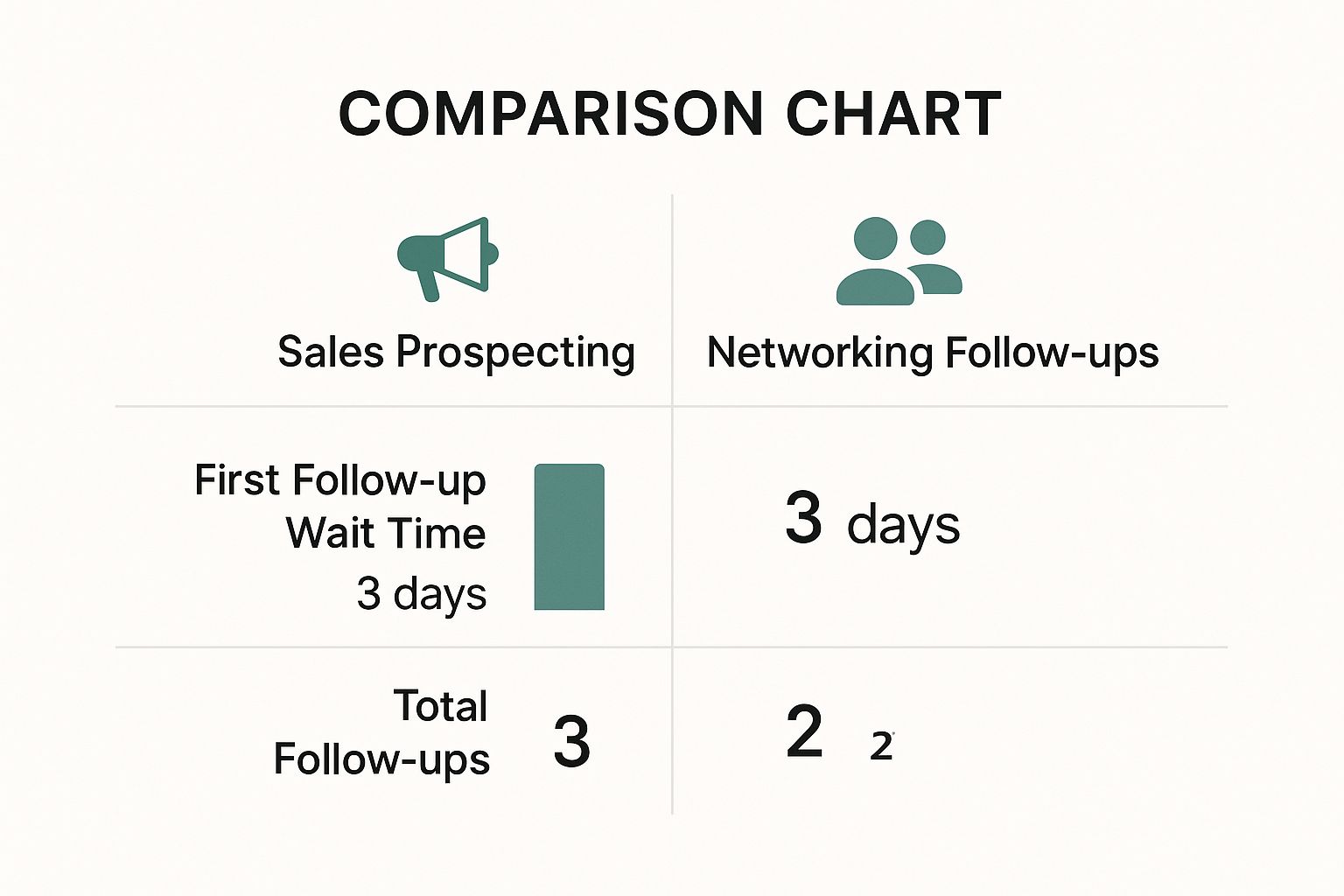
As you can see, a networking follow-up is best sent a bit sooner but with fewer touchpoints overall. It's all about making a light, respectful impression.
Don't underestimate that first follow-up—it's your most powerful one. The data is pretty clear: the first follow-up email can boost your response rate by around 40% compared to later emails in a sequence. This just goes to show how critical it is to get that initial timing right. If you want to dive deeper into the numbers, you can discover more insights about follow-up statistics and how timing really moves the needle.
Sample Follow-Up Cadence Comparison
To make this more concrete, here's a look at how different outreach goals might translate into a follow-up schedule.
| Goal | Follow-Up 1 | Follow-Up 2 | Follow-Up 3 | When to Stop |
|---|---|---|---|---|
| Warm Sales Lead | 2 days | 3 days later | 5 days later | 4-5 attempts |
| Cold Outreach | 3 days | 5 days later | 7 days later | 3-4 attempts |
| Networking | 2 days | 7 days later | 14 days later | 2-3 attempts |
| Job Application | 5-7 days | 10-14 days later | N/A | 1-2 attempts |
Remember, these are just starting points. You always have to read the room and adjust based on the industry and your relationship with the person.
Knowing When to Stop
Just as important as knowing when to follow up is knowing when to call it quits. If you've sent three or four emails and are still met with silence, pushing further can do more harm than good, potentially damaging your reputation or getting you flagged as spam.
This is where the "breakup" email comes in. It’s a graceful way to close the loop. You politely let them know you won't be in touch about this specific topic anymore but keep the door open for the future.
A well-crafted final email signals that you respect their time and priorities. It ends the conversation on a professional note, ensuring you don't burn a bridge, even if the timing isn't right for them now. This simple act of courtesy can make all the difference if your paths cross again in the future.
Common Follow-Up Mistakes to Avoid
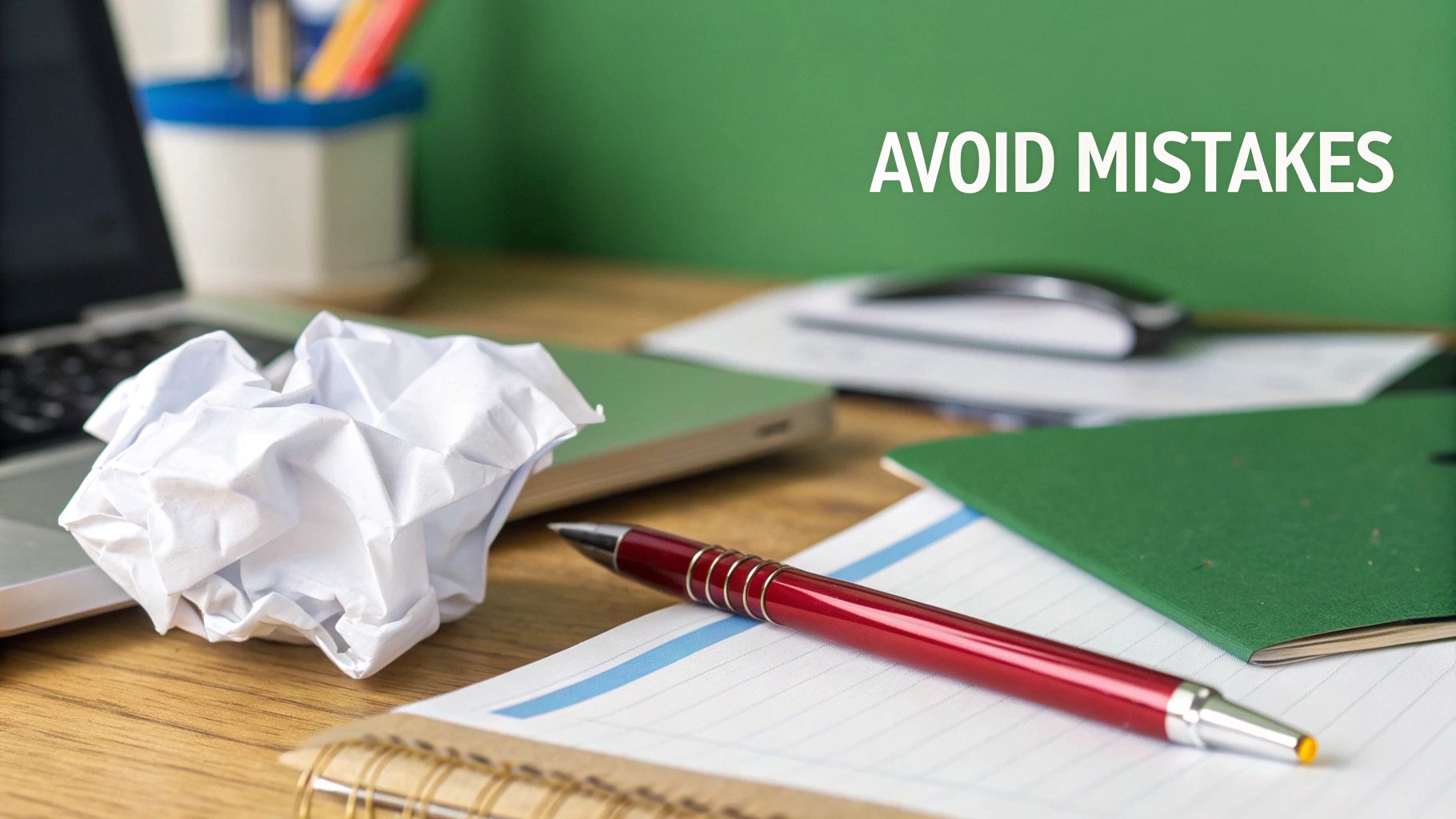
Knowing how to follow up after a no-response email is a skill, and it's surprisingly easy to sabotage your own efforts. Even with the best intentions, a poorly executed follow-up can come across as annoying, desperate, or just plain lazy—pushing a potential connection even further away.
The biggest mistake I see is people simply resending the same message. Hitting "forward" on your original email and adding "Just checking in" is the digital equivalent of tapping someone on the shoulder repeatedly. It adds zero new value and puts all the work back on the recipient to figure out what you want.
Another common pitfall is the passive-aggressive subject line. Phrases like "Re: Re: Re: Following Up" or "Just Circling Back Again…" can feel more like a guilt trip than a professional courtesy. Your goal is to re-engage, not to make them feel bad for being busy.
Failing to Add New Value
Every single follow-up is an opportunity to provide fresh value. If your second, third, or fourth email is just a rephrased version of your first, you're missing the point. Each touchpoint should offer something new, even if it's small.
Instead of a simple "nudge," try one of these:
- Share a link to a relevant case study or article.
- Offer a quick, insightful statistic about their industry.
- Mention a recent company achievement you noticed on their LinkedIn.
The purpose of a follow-up isn't just to remind them you exist; it's to reinforce that you are a helpful and thoughtful professional worth their time. Each message should build upon the last, not just repeat it.
Coming on too strong is another classic error. Sending follow-ups too frequently or with overly demanding language creates pressure and makes people want to retreat. Remember, your cadence should show polite persistence, not impatience. Finding the right balance is key to turning silence into a real conversation.
Look, even with a solid game plan, you're going to run into weird situations that make you pause and wonder what to do next. It's totally normal. Let's break down some of the most common questions that pop up when you're trying to follow up after getting radio silence.
What if I Messed Up the First Email?
It happens to the best of us. You click "send" and immediately your stomach drops—you see a typo, a busted link, or realize you attached the wrong document.
Don't sweat it. The best move is to send a quick, clean correction as soon as you spot the mistake. Keep it simple. A subject line like "Correction on my last email" is perfect. In the body, just offer a quick apology, give them the right info, and that’s it.
Pro Tip: Owning a mistake quickly and confidently actually shows you're a pro. It’s a human moment that can make your email stand out for the right reasons.
Can I Try Following Up on Another Channel?
Absolutely. In fact, it can be a slick move if you do it right. If your emails are disappearing into a black hole, a gentle nudge on a platform like LinkedIn can be just the thing to get noticed.
The trick is to be helpful, not creepy. A message like, "Hi Alex, I sent an email your way last week about [topic] but figured I'd connect here in case this is easier," works wonders. It references the email without being demanding and shows you respect their time.
How Should My Tone Change for Different Industries?
Switching up your tone is non-negotiable. A follow-up to a creative director at a hip marketing agency can have a lot more personality than one you'd send to a VP at a buttoned-up financial firm.
- Corporate/Formal: Keep it professional, direct, and respectful. Get straight to the point and focus on the value you offer.
- Creative/Tech: You’ve got more room to be conversational. Mentioning a shared interest or a recent piece of industry news can help build a quick connection.
When you mirror the communication style of their industry, it sends a clear signal: you've done your homework and you get their world.
Of course, the first step to avoiding silence is making sure you're emailing the right person in the first place. EmailScout helps you find key decision-makers with a single click, so your perfectly crafted messages actually land in the right inbox. You can discover verified email addresses and build out your outreach lists without the guesswork at https://emailscout.io.
